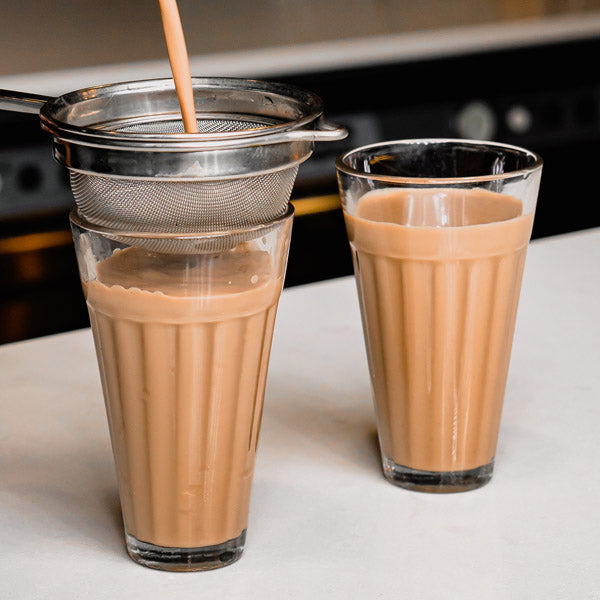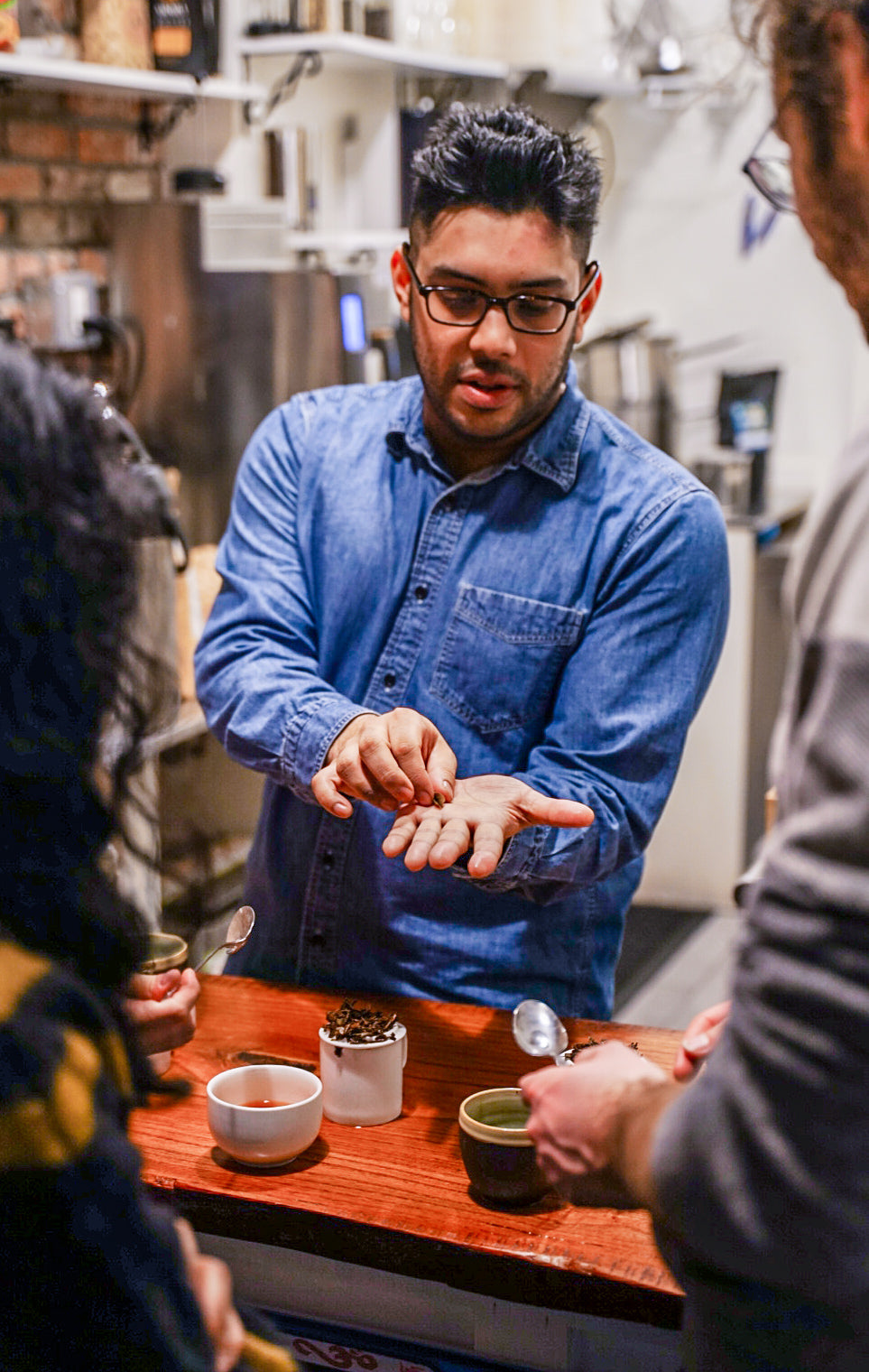- — KCC BLOG — KCC BLOG — KCC BLOG — KCC BLOG — KCC BLOG — KCC BLOG
- — KCC BLOG — KCC BLOG — KCC BLOG — KCC BLOG — KCC BLOG — KCC BLOG
What are the Ingredients in Chai?
Chai has its origins in traditional tonics of Ayurveda - the boiling of spices with water and consuming them. Filled with antioxidants, digestive properties, and even cancer battling elements, the ingredients in chai taste good and are good for you.
Let’s get into each ingredient.
Assam Tea
India is the world’s largest tea producer and the majority of it happens in the northeastern state of Assam. The Assam tea grown in this area has a distinct malty flavor and is best known for being the tea used in masala chai.
India is the most technologically advanced country in the tea industry, and the black Assam tea is considered to be one of the best types of tea in the world.
Assam
The state of Assam is situated at the foothills of the eastern Himalayas. The Bhramaputra river courses through the region and the state offers a rich natural habitat to wild animals such as the one-horned Indian rhinoceros and the Asian elephant.
Experiencing some of the heaviest rainfall in India during the monsoons, the distinct malty flavor, color, and texture of Assam black tea are due in part to the tropical climate of the area.
Robert Bruce, a Scottish tea planter who first introduced tea plants to the region of Assam in 1823 in an effort to counter China’s unilateral control on tea production. He befriended the indigenous Sanghpo tribe leader, Bessa Gaum, and was gifted with seeds and samples of the tea.
This discovery led to the beginnings of one of the greatest tea producing endeavors in the world. Assam is one of the only two regions in the world where tea grows naturally with South China being the other.
The tea
Cultivated in the northeast region of India, Assam tea is a flavorful and full bodied black tea made from the leaves of the plant Camellia sinensis var. Assamica.
Delicious to sip, it’s perfect for making a strong cup of chai. In other parts of the world, it’s consumed as a breakfast tea.
The tea itself is harvested twice a year and follows a specific growth and rest period. The rest period is when the leaves are oxidized, giving way to their distinct color and flavor properties.
The second harvest of Assam tea often called tippy tea for the golden tips on its leaves is highly regarded for its sweeter and more full-bodied flavor.
Flavors
Assam black tea has a distinct flavor. It is brisk, full-bodied and blends extremely well with milk and sugar. Its deep amber color is unmistakable and flavor notes range from notes of cocoa and smokiness with hints of spice. One sip is enough to help you realize why it’s one of the most consumed beverages on the planet today.
Caffeine
The caffeine contents in a single cup (240 grams) of Assam tea range from 60 - 112 mg, depending on how long you steep it. This is roughly about ⅓ of the caffeine that is found in a cup of coffee. The Mayo Clinic recommends having no more than 400 mg of caffeine per day.
Do the math and enjoy it responsibly!
Milk
On the streets of India, masala chai, made with tea from Assam, is always made with cow or buffalo milk. The tannins from the tea cut through the milk for a balanced, sweet and spicy flavor. If you want to avoid dairy products, you can make chai with oat milk which has a similar consistency to whole milk and tastes great.
Learn more about how to make a vegan, non dairy chai here.
Chai Spices
Chai is the combination of cha - the almighty tea leaf - with milk and sugar. But every cup of chai also has a dynamic combination of spices that give it that kick and heat.
The reason chai is so popular today is because it’s more than just a cup of tea – it’s a cup that gives you equal parts of spice and sweetness in every sip. The unmistakable flavor profile comes from how the spicy components, such as cardamom and black pepper, interact with the sweeter ingredients such as cinnamon.
Each of these spices contain more health benefits by themselves than you can imagine. With that said, let’s discover what spices make up the perfect cup of chai.
Ginger
Spices are what makes chai special. Ginger is used in traditional Indian cooking for tempering multiple dishes. Its healing properties along with its deeper spice makes it an ideal ingredient to awaken the senses and open up the pores.
Fresh ginger is ground using a mortar and pestle in traditional Indian homes and even by street chai vendors.
The juices from freshly ground ginger mix well with the boiling black tea, water, and sugar - adding a richness to the entire affair.
Black pepper
This common household seasoning gives chai heat and freshness.
Cloves
Collected as dried flowers of the clove tree, cloves are packed with antioxidants and inflammation reducing properties.
Cardamom
This queen of spices belongs to the Elettaria cardamomum species.
The first references of cardamom can be found in the Sumer texts of ancient Mesopotamia and in the ancient Indian Ayurvedic literature of India. While the original green cardamom is the gold standard for masala chai, there are many types of cardamom you can find in the market.
Types of Cardamom
• Black cardamom
Black cardamom or amomum subulatum is native to the Eastern Himalayas, and is known by many names. If the late great Notorious BIG was alive today, he’d probably be partial to badi elaichi - literally translating to “big cardamom”. The black cardamom pod carries a stronger smoky flavor and camphor like hints. It’s primarily used in rice dishes, stews, and base gravies or curries.
• White cardamom
White cardamom are essentially green cardamom pods that have been bleached white. They carry the same shapes, but look different and lose their spicy tones and give way instead to fresh tasting notes.
• Cardamom powder or Ground cardamom
Cardamom powder is exactly like it sounds. You take either the whole seed pods or just the cardamom seeds and ground them to change its texture and accessibility for seasoning.
Cinnamon
If you’re drinking chai for its health benefits, cinnamon sticks are essential to the mix. If you’re drinking chai for the taste, cinnamon sticks are also unmissable.
If a bunch of cloves got together and decided to take a river rafting trip, they’d end up being a cinnamon stick. Not citrus, not sweet, not tree bark, not entirely a clove either. Cinnamon has a unique flavor profile all its own.
A powerhouse of antioxidants, it also helps alleviate toothaches. It has been linked to cures of diseases affecting the brain and also helps your skin stay young. Not too shabby.
Saffron
Often recognized as the world’s most expensive spice, saffron is cultivated across Afghanistan, Iran, Greece, Spain and India. The origins of this vivid spice are a bit murky, with ancient Persians and Greeks both laying claim to its use in their countries.
This delicate crimson spice adds a distinct floral, aromatic flavor to any food or beverage that it’s introduced to. The reason why it’s so expensive is due to the cultivation process as each strand of saffron must be hand picked from the saffron flower.
With all due respect to Victoria Beckham, saffron is the original posh spice.
Saffron threads
The styles and stigma of the saffron flower, part of the iris family, are referred to as saffron threads. They are handpicked for a period of no more than 20 days just once every year, which is part of the reason why saffron is so expensive.
Benefits of Saffron
The delicate saffron threads aren’t just stunning to look at and smell. There are a ton of health benefits of saffron.
The antioxidants crocin and crocetin give saffron its unique red, orange, or crimson color. These compounds may be responsible for a slew of health benefits including acting as antidepressants, aiding in decreasing inflammation, preventing brain damage, reducing appetite and even possessing anticarcinogenic properties.
The effects of saffron extracts to alleviate moods is also well-documented and powdered saffron has been shown to help fight depression and invigorate libido.
Lastly, saffron can enhance any cup of chai by simply adding a few strands to a freshly brewed up. Try our Saffron Variety Pack to experience it for yourself.
Iranian Saffron
Iran harvests around 390 tons of saffron each year, making it the world’s leading producer of this red gold. It is used in everything from desserts to savories, and spoken about with great enthusiasm by the Iranians.
The Khorasan region of Iran is home to the saffron flowers, where every November, workers reach the fields before sunrise to pick the saffron threads at the perfect time.
Ancient Persian kings used to shower their subjects with gold and saffron in times of victories and celebrations. Iranians believe, rightly so, in the mental health benefits of saffron and use it in moderation in sweets, rice dishes, and enjoy its ice cream in the sweltering summers.
Greek Saffron
Third in line after Iran and India in terms of volume, Greek saffron, also known as krocus, is bright red in color and blossoms only once a year for a short period of 20 days.
The pride of Europe, the saffron threads are picked from the beautiful purple flowers in a matter of 3 days, making this painstaking and focused work. Greek saffron stands out with its bold red hue, intense aroma, and distinct flavor.
Powdered Saffron
You don’t need to be a rocket scientist to know how to make saffron powder.
A high quality saffron thread will produce a high quality saffron powder. But if you’re purchasing it, just double-check to ensure that it isn’t mixed with other spices like turmeric or paprika. Sprinkle it over traditional Persian or Indian rice based dishes to elevate the flavor profile.
Commercial Saffron
With an average price of $13,000 a pound, saffron has the power to change the lives of farmers who produce it and transform their regions significantly as a result of it. We use single origin saffron from the Herat region of Afghanistan which is sourced by our friends at Burlap and Barrel.
Saffron Chai
Saffron has a place in masala chai and is often used as the sole spice in Kesar Chai or saffron tea. Everyone has their own methods of when to add the saffron but our version is the one found in the streets of Kolkata. Simply add a few saffron threads on top of a freshly made cup of chai and wait for it to fully dissolve before giving it a taste.
Saffron is a rich, vibrant, and aromatic spice that adds a touch of elegance to everything it touches.
Jaggery
Knock knock.
Who’s there?
Jaggery.
Jaggery who?
You know, jaggery! Gur. Tapa dulce. Piloncillo. Gula melaka. Kokuto.
Jaggery is a concentrated form of sugar derived from cane juice. Where traditional white sugar occurs in crystal form; jaggery is what you get when the molasses and crystals from cane juice remain intact.
The final product is a non-centrifugal block that is sticky, solid, and melts beautifully in chai.
Sugarcanes
Growing 2-6 meters tall, sugar cane is the source of multiple sugars. Believe it or not, cane is part of the same grass family that includes sorghum, rice, and wheat. Despite us all doing our best to reduce our sugar consumption, no cup of chai is fully complete without it.
Juice
Sugarcane juice is a refreshing beverage, enjoyed with a generous helping of ice.
While you can find the juice sold in streetside carts, there are still devoted sugarcane cafes in India, giving people a well-deserved rest from the sweltering heat.
Served with a salty masala spice, sugarcane juice may also feature freshly squeezed lemons and pineapples to enhance the overall flavor.
White sugar
When you take sugarcane juice and start to boil it, a lot of interesting things start to happen.
In a world with so many healthy and nutritional sweetener options, white sugar is that readily available over-the-top sweetener that just about everyone swears they’re quitting.
White sugar is sucrose. After sugarcane juice is boiled, it undergoes a filtering with slaked lime and boiled until it crystalizes. These crystals are then dried, turning it into raw sugar or brown sugar.
A second liquefying process is performed to ensure that the color no longer remains. The sugar is put into a centrifuge and sugar crystals are ground into various shapes for use.
Unrefined sugar
Processed white sugar is generally considered an unhealthy additive by physicians and nutritionists alike. Because most foods naturally have sugar content within them, adding refined sugar adds no value - except sweetness. Unrefined sugar is a healthier way to cater to the sweet tooth.
Jaggery, date sugar, maple syrup, agave nectar, brown rice syrup and coconut sugar are common examples of unrefined sugar.
Benefits of jaggery
Delicious, complex, unrefined and nuanced. Health benefits of jaggery include helping build hemoglobin, treating menstrual cramps, flushing toxins out of the system, cleaning the stomach, intestines, respiratory tract, and food pipe. It helps digestion as well as relieves constipation.
Some have found that a teaspoon of jaggery daily helps with migraines.
Indian grandmas are famous for using a little bit of gud (jaggery), turmeric, and ghee mixture to fight cough and common colds. We can confirm this one.
Jaggery in Chai
Strikingly similar in color to chai, jaggery is a perfect accompaniment to chai. You can ground it and add it right along with the initial water pot or brew a sugar free cup and add it after.
While amazing in taste, boasting notes of molasses, cane juice, and a hint of caramel; jaggery is less concentrated in its sweetness. Add according to taste.
Palm jaggery
Boiling and condensing the sap from palmyra trees is a long yet worthwhile process used to make palm jaggery.
Cane jaggery
Sugarcane juice is a delicacy in many parts of India and often consumed as a refreshment in the sweltering heat.
Cane jaggery is manufactured by crushing the sugarcane, filtering the juice, boiling it to create a concentrate and then allowing it to cool and crystallize into jaggery blocks.
Foods
You can find jaggery used in several foods due to its complexity of flavors. It is used in dals (lentil soups), ladoos, panelas, Thai curries, puddings, rotis, and desserts of all varieties.
The largest manufacturers of jaggery are India, Australia, Brazil, Germany, Mexico, and Thailand. And the largest importers are the United States, Malaysia, Indonesia, and Japan.
Health
While both types contain several health benefits; jaggery should be consumed in moderation - it is after all a sweetener. Overindulgence in even the best of things can present health issues. Palm jaggery is said to have the edge in terms of nutritional value, but both forms contain several health benefits.
What is Masala?
When one travels to India or thinks of the East, the first thing that comes to mind is the fragrant, flavorful, fulfilling food. The key to every mouthwatering Indian recipe is the mighty masala, which morphs ordinary meals into extraordinary mouth watering experiences. Masala translates to “a blend of spices” but the nuances come in the different varieties and combinations.
Spices
While they form the flavor bed of all recipes, masalas are also used for their nutritional properties contained within the spices.
Any number of masala mixes may be full of antioxidants, aid in digestion, prevent inflammation, fight nausea, and help counter the negative effects of other ingredients.
Spices have literally formed the foundation of our modern world by being the main reason for global trade and commerce. In times as early as 2000 BC, traders traveled the spice routes exchanging goods and spices such as cinnamon, cassia, nutmeg, sandalwood, and much more.
Masala
In an Indian home kitchen, the masala box is the holy grail behind every meal created. A humble yet airtight container, it stores a variety of spices to be used to their full potential by whoever decides to throw the chef’s apron on that evening.
Spice blend
Masala is a combination of complementary spices that form distinct flavors that are commonly used in staple dishes across South Asian cooking.
Garam masala
Garam masala is a key spice mix used predominantly in tikka masalas, chana masala, and a slew of other recipes. It consists of cumin, green cardamom, cinnamon, cloves, black pepper, fennel seeds, star anise, nutmeg, mace, black cardamom, and bay leaves. While this is the base, every home and region may slightly deviate to add their own twist to the spice combo.
Tandoori Masala
If you’re in search of deep smoky flavors that tantalize the taste buds; sprinkle a helping of Tandoori masala in your next dish.
This blend of spices emerges from the combination of cumin, coriander seeds, dried ginger powder, turmeric powder, mace, salt, cloves, and garlic. While variations exist, this is the staple mixture of a Tandoori masala.
The Tandoori masala is used as a marinade for ingredients that are baked inside of the traditional clay oven - tandoor. It can also be mixed with yogurts to form a potent base for a delicious entree.
Chaat masala
Glasses of fresh sugarcane juice, buttermilk, and lemonade are sometimes infused with a special chaat masala. Just a tinge of the stuff will elevate the entire beverage. The natural sweet and sour flavors of the drinks blend well with the salt, black salt, cumin seed powder, asofeotida, and black pepper powder perfectly.
Chaat masala can also be found in savory South Asian snacks such as pani puri, sev puri, and bhel puri.






